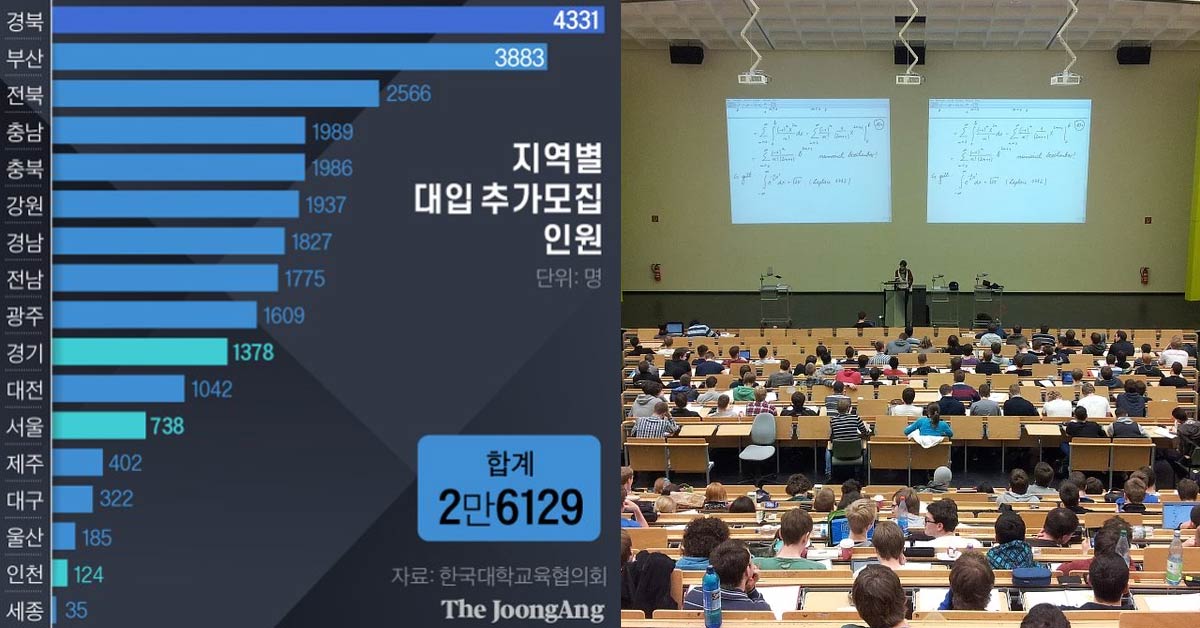In the 2021 school year, as universities that could not fill the number of colleges continued to fill in, the number of additional recruits increased to 26,000. It is the largest in 16 years since the entrance examination in 2005. In particular, additional recruitment of universities in non-metropolitan areas exceeded 90% of the total.
Less than last year 3 times… 91% of local costs
The school-age population is plunging and the capacity is not filled
Recruitment of 20 additional medical, dental and oriental medical students
According to the Korean Council for University Education on the 22nd, the number of additional recruitment held at 162 four-year universities this year was 26,129, nearly three times higher than the previous year (9830). In particular, as of 2 p.m. on that day, the number of additional recruits for local medical departments (pre-medicine, pre-dental, and pre-Organic) was counted as 20. Additional recruitment will take place for 6 days from the 22nd to the 27th.
Additional recruitment is conducted only at universities that have not filled the quota even though additional candidates for regular recruitment have been selected. Most of the additional recruitment this year is concentrated in local universities in the non-metropolitan area. The total number of additional recruits in Seoul, Gyeonggi, and Incheon is 2240, which is only 8.6% of the total, but non-metropolitan areas account for 23889, or 91.4%.
By region, Gyeongbuk was the largest with 4331 people, followed by Busan (3883), Jeonbuk (2566), and Chungnam (1989). The total number of regular recruitment at universities in Gyeongbuk is 9,000, which means that nearly half of them have not been filled. Among the universities, local private universities such as Daegu University (Gyeongbuk, 876 students), Dongmyeong University (Busan, 804 students), and Sangji University (Gangwon, 769 students) did not fill more than half of the regular recruitment.

The number of additional recruitment for college admission by region. Graphic = Reporter Kim Kyung-jin [email protected]
Not only private universities, but also among regional bases and national universities have not been able to fill the capacity, so there are not a few places that are recruiting more. Nine regional universities, including Gyeongbuk National University (135 students) and Gyeongsang National University (123 students), are recruiting 715 additional students.
Experts on entrance examinations blame the declining school-age population as the cause of the massive shortfall in local universities. The number of applicants for the 2021 University Academic Proficiency Test (SAT) was 49,3433, a decrease of 55,301 from the previous year (54,8734). The number of applicants for the SAT is 60,000 less than the university entrance quota (55,5774).
Lee Man-ki, director of the Yuwei Education Evaluation Research Institute, said, “As the school-age population declines rapidly, this phenomenon will intensify in the future.” Local universities have an emergency in their normal operation, but there is no suitable countermeasure. A professor at a private university in Busan confessed, “The decline in the school-age population will proceed faster in the future, but I don’t know what measures to take to get out of the crisis.”
It is not known whether the crisis can be escaped with additional recruitment. Seong-ho Lim, CEO of Jongno Academy’s Sky Education, said, “Normal 90% of the students are recruited through additional recruitment, but this year, the number of candidates is very small, and universities with more than 200 additional recruits are likely to be less than 30-40%.”
As the number of applicants decreases in local universities, there are cases in which students pass with extremely low grades. In one college admissions community, a case of passing the mathematics department at a local national university even though he received an average grade of 6 or lower on the SAT became a hot topic. In this department, 49 people applied for the selection of 19 students, but the successful candidates passed through to other universities and additional passes continued, leading to the lowest grades.
Reporter Jeon Minhee [email protected]
